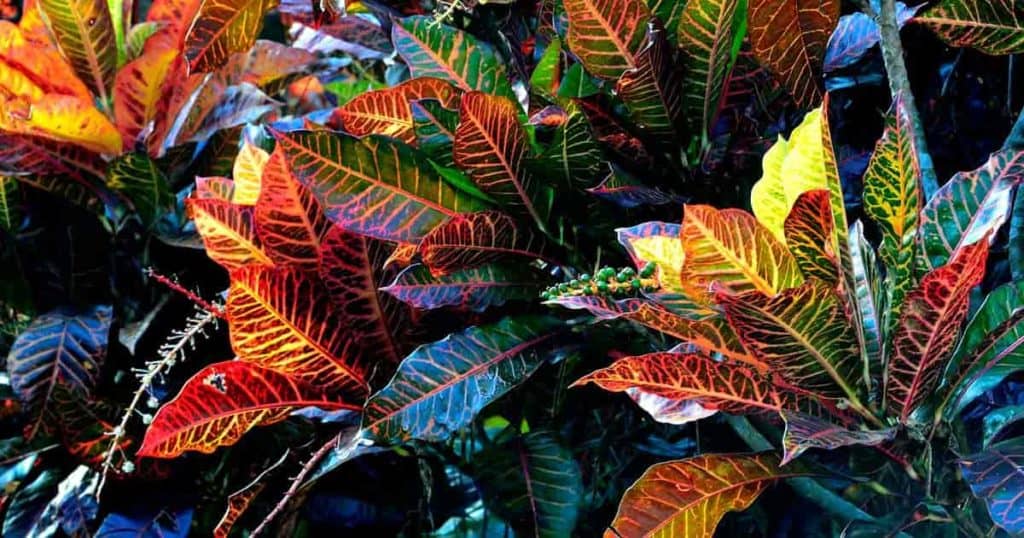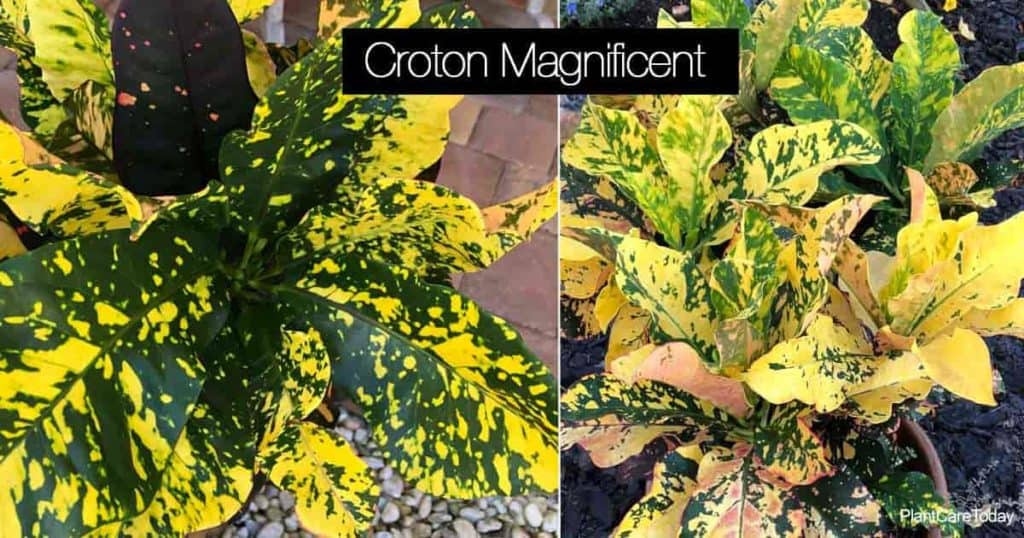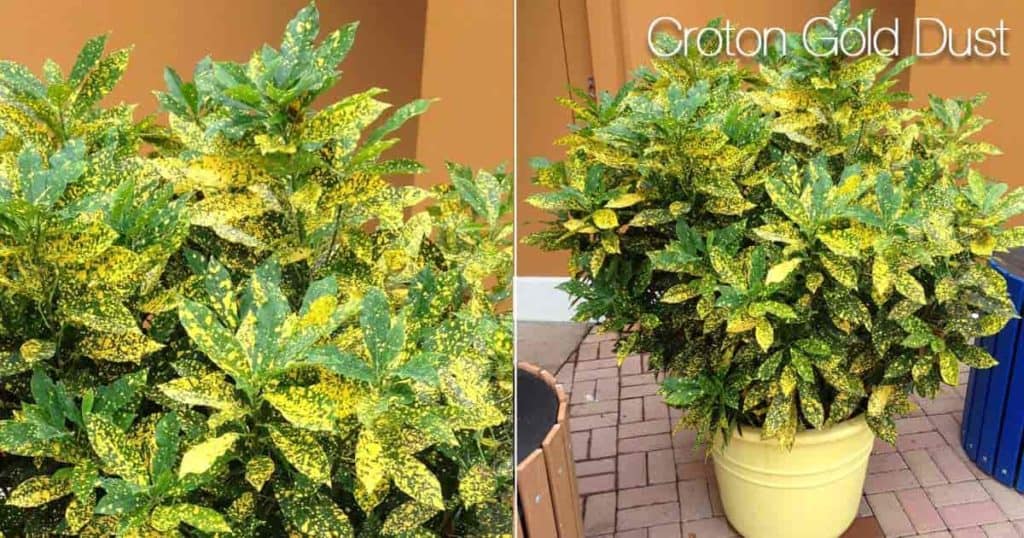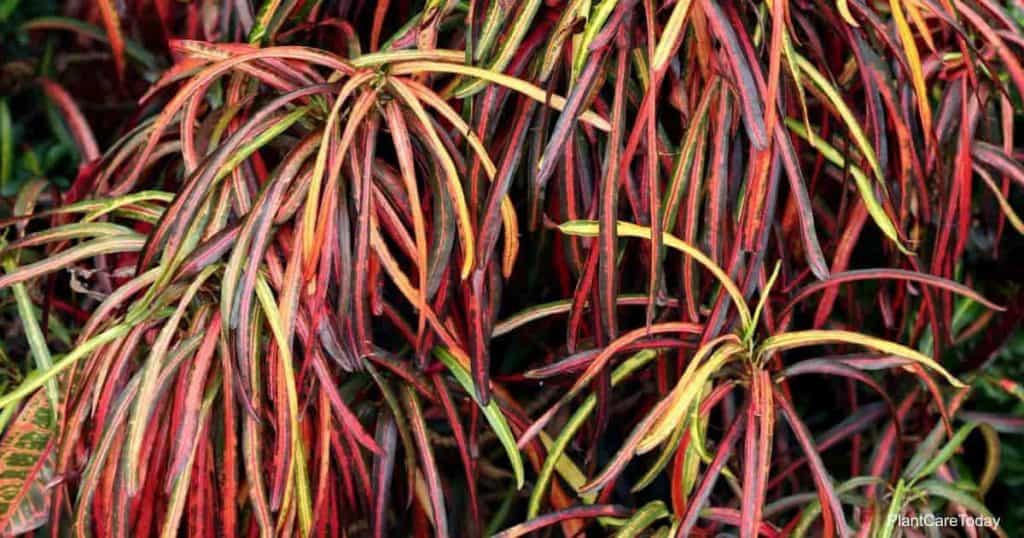The Croton plant, aka Codiaeum variegatum (pkoh-dih-EE-um var-ee-GAY-tum), is a colorful indoor/outdoor tropical plant is native to Malaysia, Sri Lanka, and India.

The word croton is Greek for tick because the shape of the leaves resembles such.
Variegatum means variegated, which reflects the wildly colorful leaf patterns and variety. This makes the variegated croton plant incredibly popular for their foliage.
In this article, we’ll provide an overview of the care of the croton. Then we’ll discuss some of the popular Croton varieties and cultivars of this beautiful plant.
Croton Uses, Care, And Maintenance
Croton plants are quite easy to care for as long as you don’t overwater them. Use well-drained rich potting soil, and mist the leaves in low humidity environments from time to time.
Croton plants can live as an outdoor plant in any warmer climate, such as Florida or the Caribbean. Planted together outdoors, crotons create visually appealing border vegetation or accent pieces.
In any other environment, they serve well as houseplants. You may want to look for varieties that are well suited for indoors and better keep their bright color inside.
Most croton varieties are very popular, due to the wide assortment of leaf shapes different varieties display. You’ll find oval, elliptical, ribbon, and rounded leaves, to name a few.
Croton leaf color can vary between white, green, orange, yellow, red, pink, and purple.
The vibrant color of croton leaves changes depending on how much light it receives. Less light exposure means greener leaves. Brighter lit rooms will change the leaf color to a more orange or red shade.
The easiest way to get your croton leaves back to orangey tones is to take it outside into the sunlight while the weather is warm. Wait for the leaves to change color.
How To Grow Croton Plants
In general, crotons flourish in shifting full sun conditions. That doesn’t mean they won’t thrive in partial shade environments.
Some varieties do better in light shade. Too much direct sunlight may fade leaf color and affect the growth of the plant.
When choosing an outdoor location, select a place positioned to take in the shifting sun.
Related: Read our article on Croton Leaves Falling Off if your croton houseplant is losing leaves and do not know why.
Soil
Crotons prefer well-drained soil, whether outside in the ground or inside in containers.
Environment
Croton plants do very well in warm, humid climates (USDA zones 9b to 11) such as in subtropical regions.
Related: Tips on Croton Plant care in winter.
Water
Croton plants consist of thick, shiny leaves that are sensitive to overwatering. Yet, they need frequent watering since they are such humidity lovers.
If your croton lives in a dry environment, it may do it some good to mist it with water from time to time.
Croton plants love water, but it might suffer root rot if you give it too much.
Water often and pay close attention to the younger leaves on the plant. If they begin to wilt, your croton plant needs more watering.
Related: Learn tips on Croton Fertilizer here.
Pruning
Crotons can sometimes get leggy when indoors. If this happens, cut your stems back up to ⅓ of the length and no further. Use the stem cuttings to start new plants after dipping the ends in a rooting hormone.
NOTE: When pruning crotons wear gloves to protect yourself from the sap that can cause skin irritation. Keep an eye out for spider mites, mealybugs, and other pests infestation.
List Of Popular Croton Varieties
Croton Petra
Croton Petra displays rainbow-colored variegation that intensifies with increased exposure to the sun.

This variety of croton can grow up to 6′ feet tall, so give it plenty of space.
Croton Mammy
Croton Mammy has colorful, twisted, and curled leaves.

Croton Magnificent
The Croton Magnificent got its name from the bright yellow color splashed throughout its green-colored leaves.

Like all crotons, it can live outdoors in warm, humid environments as an evergreen.
Croton Gold Dust
The Croton Gold Dust plant is more petite than others, such as the Croton Magnificent or Croton Mammy. It will grow up to 3′ feet tall indoors or outdoors.

It is so named for its leaves that appear dusted with specks of gold.
Croton Sunny Star
The Croton Sunny Star features elliptical or elongated circular shaped leaves with a spattering of sunny yellow. This particular croton grows up to 5′ feet when planted outdoors.
Croton Luna
Luna croton, has variegated foliage with long, straplike dark green leaves, with a dark orange stripe up the middle and a similar look as Zanzibar.

Croton Zanzibar
Croton Zanzibar is a unique and showy type of croton. Its narrow leaves cascade out from a central base like an explosion of fireworks.

Crotons are beautiful, humidity loving evergreen plants that can grow well both indoors and outdoors as landscaping shrubs. These colorful plants come in various shapes and heights and serve as beautiful additions to any home or landscape.